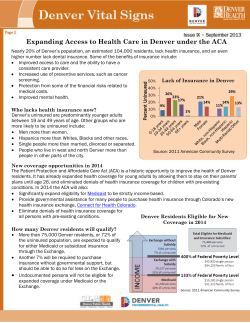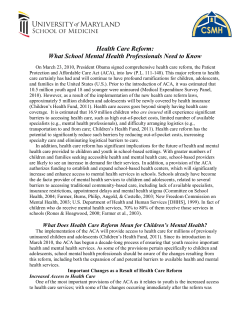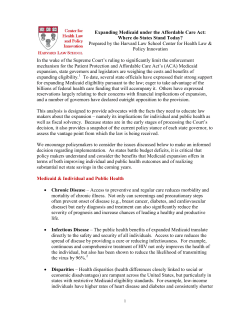
THE AFFORDABLE CARE ACT
THE AFFORDABLE CARE ACT End of the Beginning or Beginning of the End? Virginia Academy of Nutrition and Dietetics April 7, 2014 Carolyn Long Engelhard, MPA Director, Health Policy Program Department of Public Health Sciences University of Virginia School of Medicine THE PROMISE of the Affordable Care Act: to expand health coverage through… Individual mandate Expanded Medicaid Coverage Health Insurance Exchanges (up to 138% FPL) (subsidies 100-400% FPL) Employer-Sponsored Coverage The CBO estimates that under the ACA 92% of legal U.S. residents will have health coverage by 2022 – up from 82% in 2012 HEALTH COVERAGE makes a difference 3.0 2.9 Ratio of probability of diagnosis of late vs. early stage cancer, Uninsured/private insurance 2.5 2.3 2.0 2.2 Equal likelihood between Uninsured and Insured 2.0 1.5 1.0 Uninsured women with breast cancer have a risk of dying that is between 30-50% higher than for insured women (IOM) 0.5 0.0 Colorectal Cancer Lung Cancer Melanoma Breast Cancer 81% of the nonelderly uninsured say they have delayed or skipped care in the last year Uninsured have a 25% greater mortality risk than adults with coverage SOURCE: Kaiser Family Foundation, based on Halpern MT et al, Association of insurance status and ethnicity with cancer stage at diagnosis for 12 cancer sites: a retrospective analysis." The Lancet Oncology. March 2008. 1 AN UNINSURED patient’s perspective One night on stage, 28-year-old comedian Julian McCullough had an intense pain in his stomach, which he assumed was food poisoning He was diagnosed in the ED with a ruptured appendix, treated with IV antibiotics for 4 days, followed by surgery Julian: I grew up in a family without health insurance my whole life, and our policy was Julian’s story was recorded at Told, a storytelling show in NYC and then heard on PBS’ This American Life basically ‘Give it a couple of weeks’… so I didn't want to call 911 or go to an Emergency Room AN UNINSURED patient’s perspective Clip courtesy of This American Life from WBEZ Chicago (#429, June 24, 2011) THE NEED for “good enough” insurance… Medical bills are the leading contributing cause for personal bankruptcy in the U.S. 78% of filers of personal bankruptcy caused by medical problems have medical insurance at the start of their illness (2007 data) CDC 2014 survey: 1 in 4 Americans struggle to pay medical bills The director of the federal Consumer Financial Protection Bureau reports that half of all accounts reported by collection agencies now come from medical bills, and the credit record of 1 in 5 Americans is affected. Himmelstein DU, Warren E, Thorne D, Woolhandler S. MarketWatch: Illness And Injury As Contributors To Bankruptcy. Health Affairs, no.W5(63), 2005; http://blogs.marketwatch.com/healthexchange/2014/01/23/majority-of-those-eligible-for-health-assistance-wont-get-policies-study/ ; http://www.seiuhcpa.org/2014/02/03/25-of-america-struggling-to-pay-medical-bills/ 2 KEY ELEMENTS of the ACA insurance coverage provisions Individuals and families will be able to purchase subsidized insurance through exchanges operated by the federal or a state government States may expand Medicaid but may decline to do so Most legal residents in the U.S. must either obtain insurance or pay a penalty tax Employers with more than 50 employees that decline to offer minimum health coverage will be assessed penalties Insurers may not deny coverage to people on the basis of their health status or charge enrollees in poor health higher insurance premiums GOING TO the Health Insurance Exchanges Open enrollment Oct ‘13 – Mar ‘14 4 tiers of “metal plans” All plans must offer 10 categories of essential benefits Plans can charge people more only because of age and/or tobacco use Premium tax credits 100-400% FPL 80% of enrollees are expected to be eligible for tax credit subsidies Insurers are counting on enrollment from relatively healthy participants to balance out the higher medical claims incurred by older, sicker people NEWLY INSURED under Medicaid expansion Approximately 11 million newly insured through Medicaid by 2016 New Medicaid enrollees will be younger, less obese, and less depressed compared to traditional Medicaid population – but will include more smokers and heavy drinkers. http://www.nbcnews.com/health/new-medicaid-patients-may-be-younger-states-feared-study-finds-8C11116642 3 WHERE WE ARE NOW: Health Insurance Exchanges (HIX) and Medicaid Expansion Who is running the HIXs? • 14 + DC run own HIX • 36 states have federally run HIX • Enrollment: Oct 1, 2013 – Mar 31, 2014 – Majority of uninsured unaware of deadline – Only 27% of HIX enrollees previously uninsured Estimates = 6M in HIX in 2014; 24 M by 2017 Over 4 million people picked a health insurance plan through the exchanges through Feb 2014 – and about 1.5 million in 28 states are opting to stay in plans that are not compliant with the law (option recently extended through 2016) Will states accept Medicaid expansion? [FEDERAL GOV’T PAYS 100% FOR 3 YRS, THEN DECLINES TO 90% IN PERPETUITY] States can opt in or out at any time Expanding program (25 + DC; 4 states leaning) = +8.9M eligible but only ~3.5M new sign-ups Not expanding so far (21) = ~ 5M who would have been covered in 2014 http://www.nytimes.com/2013/10/03/health/millions-of-poor-are-left-uncovered-by-health-law.html?pagewanted=2&hp ; http://www.advisory.com/Daily-Briefing/Resources/Primers/MedicaidMap WHO ARE the 4.2 million enrolled through 3/1/2014? HOW THE NUMBERS BREAK DOWN: 55% are female 45% are male. 31% are age 34 and under 25% are between 18 - 34. 63% selected a Silver plan 18% selected a Bronze plan 83% of those who selected a plan are eligible for premium tax credits The Obama Administration last year estimated that 5.65 M would be enrolled by February The proportion of younger Americans signing up for coverage has remained below the numbers believed to be necessary to keep premiums stable (40%). http://online.wsj.com/news/articles/SB10001424052702304250204579433500359707662?mod=djemPoliticsPolicy&mg=reno64-wsj WHERE STATES stand on Medicaid expansion The states that have rejected the Medicaid expansion are home to about half of the country’s population but 60% of the poor – 5M uninsured with incomes <100% FPL live in states that are not expanding Medicaid – and they also are not eligible for insurance subsidies on the state-based Exchanges WHAT WILL STATES DO ABOUT EXPANDING MEDICAID? Past experience shows that states rarely refuse federal dollars. More than half of states implemented Medicaid within the first year federal funding became available, and nearly all states were participating within four years http://www.advisory.com/Daily-Briefing/Resources/Primers/MedicaidMap 4 Virginia and the ACA Gov. McDonnell decided in December, 2012 To default to a federal health insurance exchange with the understanding that the state could change course later To bow out of the Medicaid expansion, warning of Medicaid's skyrocketing costs and other state needs VIRGINIA and the ACA Eligibility for coverage as of 2014 among currently uninsured Virginians Virginia has some of the strictest criteria for Medicaid eligibility in the country, ranking 48th in per-capita spending for the program If Virginia expands Medicaid and MEDICAID EXPANSION GROUP fully implements the Health Insurance Exchange, the number of uninsured would fall to approximately 436,000 from 1 million (6% from 15%) If Virginia does not expand Medicaid, the number of uninsured is estimated to remain around 800,000 http://kff.org/health-reform/fact-sheet/state-profiles-uninsured-under-aca-virginia/; http://www.thecommonwealthinstitute.org/wp-content/uploads/2012/07/Making-the-Right-Choice-on-Medicaid.pdf ; http://www.timesdispatch.com/news/study-examines-economic-impact-of-medicaid-expansion-in-va/article_d7d716b0-8888-589e-9e09-66a9a40655df.html; http://healthaffairs.org/blog/2014/01/30/opting-out-ofmedicaid-expansion-the-health-and-financial-impacts/print/ VIRGINIA and the Federal Health Insurance Exchange 580,000 currently uninsured nonelderly people in Virginia are eligible for coverage through the HIX -- 352,000 are eligible for premium tax credits Virginians will choose from an average of 47 different plans; 4 “metal” levels of coverage (bronze, silver, gold, platinum) Cheaper plans carry higher cost-sharing Average premium in Virginia, w/o tax credits = $237/mo for bronze plan, and $335/mo for benchmark silver Family of 4 making $50,000 will pay $282/mo with tax credit ($799 without) 27 yo making $25K will pay $80/mo w/ tax credit for bronze and $145/mo for silver HIX activity: VA vs (total nat’l) thru 3/1/2014 251,566 eligible to enroll in HIX plan (8.7 M) 133,492 eligible for financial assistance (5.2 M) 33,897 eligible for Medicaid/CHIP (4.4M) 102,815 (80% subsidized) have selected a plan (4.2 M) http://capsules.kaiserhealthnews.org/index.php/2013/03/dick-and-jane-sign-up-for-the-exchange/ ; http://aspe.hhs.gov/health/reports/2014/MarketPlaceEnrollment/Feb2014/ib_2014feb_enrollment.pdf http://kff.org/report-section/state-by-stateestimates-of-the-number-of-people-eligible-for-premium-tax-credits-under-the-affordable-care-act-table-1/ ; http://kff.org/health-reform/fact-sheet/state-profiles-uninsured-under-aca-virginia/ 5 VIRGINIA and the Medicaid Expansion Typically, Virginia hospitals defray indigent care with DSH funds. In 2013, Virginia hospitals received over $90M in DSH payments – the 28th highest in nation COVERAGE GAP These payments will be reduced under the ACA b/c the Medicaid expansion was envisioned as a coverage substitute. The indigent care shortfall for UVA & VCU will be $386M 2017-2022 69% of uninsured Virginians would be eligible for coverage assistance using HIX tax credits and Medicaid if expanded, but only 37% if the state does not expand Medicaid, leaving approximately 190,000 in a coverage gap – unable to enroll in Medicaid and unable to get tax credits in HIX If Virginia expands Medicaid the state would save $1B over 9 years and replace 95% of DSH payments (VHHA: Va losing $5M/day by not expanding Medicaid) http://www.thecommonwealthinstitute.org/wp-content/uploads/2012/07/Making-the-Right-Choice-on-Medicaid.pdf; http://www.urban.org/publications/412918.html; http://states.aarp.org/expanding-affordable-health-care-is-top-aarp-virginia-legislativepriority/ THE POLITICS: Current status of ACA in Virginia The VA General Assembly adjourned March 8th without a budget, mainly because of the stand-off between the new Governor McAuliffe and the Republican controlled House of Delegates. They will reconvene March 24th for a special session Between 2014 and 2022, Virginians will pay over $26 B in taxes related to the ACA, subsidizing either its own or other states’ Medicaid expansion programs http://www2.timesdispatch.com/news/virginia-politics/2012/nov/07/4/mcdonnell-leans-toward-federal-exchange-for-va-ar-2345032/; http://hamptonroads.com/2013/02/virginias-medicaid-expansion-plan-moves-forward ACA EARLY FINDINGS: FINDINGS What do we know? Getting to universal coverage will be a long process Unlike other countries, Americans have to “opt in” voluntarily – and many will choose to opt out and pay the penalty (estimated 40% of uninsured in 2014) Tax credit (subsidy) eligibility is strongly correlated with enrollment Enrolling in an HIX is 62% for those eligible for a tax credit and 19% for those who are not – generating more unrest among higher income In states that have not expanded Medicaid, people are falling into the coverage gap Childless adults are generally ineligible for Medicaid no matter how low their incomes 6 PROMISES AND PITFALLS of the Affordable Care Act CBO projects 25 million will gain coverage by 2021, but 31 million will still be without coverage ACA regulates insurance, pushes payment changes based on value and provider accountability – but unclear that will help persistent disparities by socioeconomic status, race, and ethnicity Premiums (with tax credits) may be lower than ESI on the HIX but they often come with high deductibles and narrow networks – unaffordable and unpopular – may promote “underinsured” among low-income Labor force effects: 2.3 million fewer equivalent jobs in 2021 – no more job lock vs. less work for gov’t subsidies - positive or negative for the economy? ACA has winners and losers (ill vs healthy; older vs younger, low-income vs higher-income, etc.) HOW ACA will benefit nutritionists and dieticians The ACA will now cover preventive counseling services related to healthy diets Diabetes Hypertension Counseling w/o complaint or sickness Dietary counseling Exercise counseling Counseling for health – advice, education, instruction Nutritionists and registered dietitians (RDs) may be included in patient-centered medical homes Although insurance companies and networks are required to provide coverage under the ACA, there may be some restrictions (prior authorization requirements, deductibles and co-insurance, etc.) – so read “fine print” carefully MGMA Connextion – July 2012, p. 32-33 LOOKING AHEAD: Will the 2014 elections be a referendum on the ACA? Wall Street Journal / NBC News Poll – March 5-9, 2014 36 senate seats are up in 2014 36 Governors will be elected in 2014 70% of Republicans support repealing the ACA (47% all voters) 75% of Democrats support fixing and keeping the ACA 37% of Republicans and 55% of Democrats said their views of the health care law will not necessarily reflect their vote for Congress 34% said their member of Congress deserves re-election, compared to 55% who want to give someone else a chance 54% said they would oust every single member of Congress if they could http://blogs.wsj.com/five-things/2014/03/12/5-takeaways-from-the-wsjnbc-poll/?mod=obafive; http://online.wsj.com/news/articles/SB10001424052702304250204579433533118580224?mg=reno64-wsj 7 Questions? 8
© Copyright 2025





















